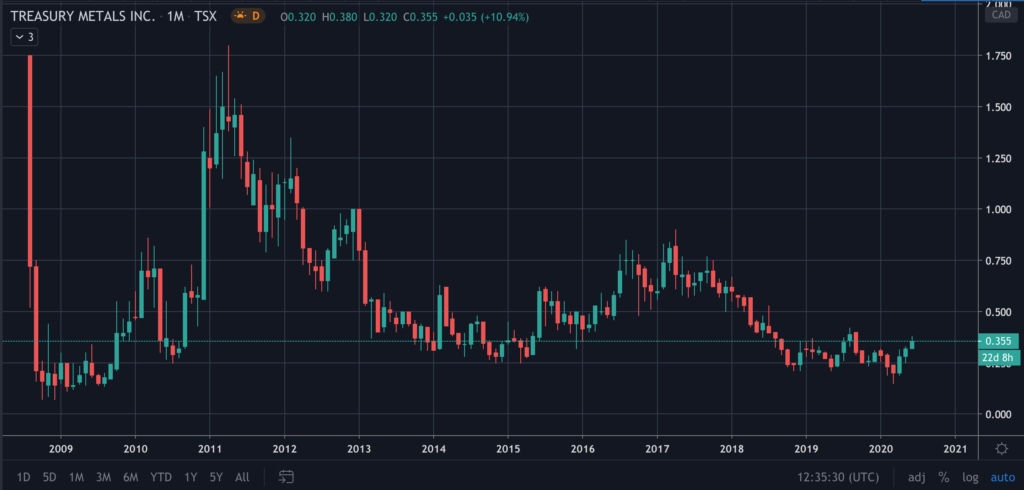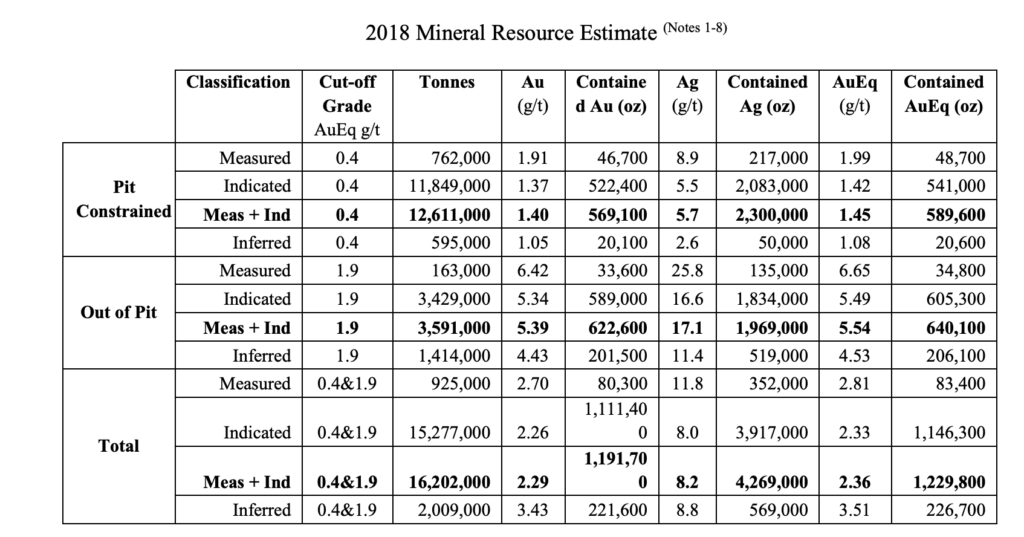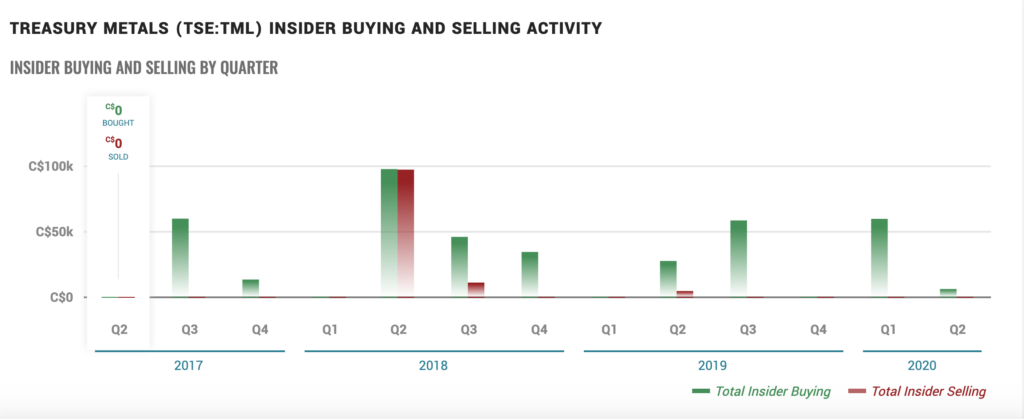Common Stock: Treasury Metals (TSX:TML)
Current Market Price: $.355 CAD
Market Capitalization: $60.2 million CAD
**Note: All values in the article are expressed in Canadian Dollars (CAD) unless otherwise noted

Treasury Metals Stock – Summary of the Company
Treasury Metals is a mineral exploration company focused on the acquisition, exploration, and development of gold properties in the Americas. Their flagship property is the Goliath Gold Project in Ontario and they also own several other exploration stage properties. Treasury Metals was founded in 1997 and is headquartered in Toronto Canada.
Revenue and Cost Analysis
Treasury Metals does not own any properties that are currently producing and therefore does not have any revenue. The company consistently runs a net loss and is likely to continue to do so for the foreseeable future.
In 2019, the company had a net loss of $4.8 million, on par with a net loss from 2018 of $4.5 million. Most of the companies expenses are administrative and compensation related.
Treasury Metals – Royalty and Streaming Agreements
The Goliath Gold property has two claim royalty’s which each require payment of $50,000 annually.
Treasury Metals – Mineral Resources
The Goliath Gold project has “measured and indicated” resources totaling 1,191,700 ounces of gold and 4.2 million ounces of silver.

Balance Sheet Analysis
Treasury Metals has a weak balance sheet with low liquidity and high debt levels relative to its stage of development. At the end of 2019 current assets totaled $1.9 million, including $1.6 million in cash, compared to $3.7 million in current liabilities.
The company has one major long-term asset comprised of mineral exploration properties. At the end of 2019 this asset was valued at $80 million. Total liabilities were $11.5 million.
Treasury Metals – Debt Analysis
The company has $4.8 million in long term debt outstanding which carries an interest rate of 12 month LIBOR plus 6.5%.

Treasury Metals Stock – Share Dynamics and Capital Structure
As of March 2020, the company had 169.7 million common shares outstanding. They also had 31.5 million warrants and 9.7 million options. Fully diluted shares outstanding is 210.9 million shares.
Treasury Metals has a highly dilutive capital structure and will likely further dilute existing shareholders in the future. Investors should carefully consider their place in the capital structure before investing.
Treasury Metals Stock – Dividends
The company has never paid a dividend and has stated it plans to retain any future earnings for the foreseeable future.
Management – Skin in the game
Insiders at Treasury Metals have been net buyers of the stock over the past few years and insiders own about 5% of the outstanding Treasury Metals shares. This is generally viewed as a bullish signal for the stock.

Treasury Metals Stock – 3 Metrics to Consider
Debt to Equity Ratio
Total Liabilities/Total Share Holder Equity
$11.5 million/$72.8 million = .16
A debt to equity ratio of .16 implies that the company relies mostly on equity financing to fund itself.
Price to Book Ratio
Current Share Price/Book Value per Share.
$.36/$.35=1.03
Based on fully diluted shares outstanding, Treasury Metals has a book value per share of $.35. At the current market price this implies a price to book ratio of 1.03, meaning the company’s stock currently trades at the book value of its assets.
Working Capital Ratio
Current Assets/Current Liabilities
$1.9 million/$3.7 million = .5
A working capital ratio of .5 indicates short term liquidity constraints, meaning the company may have issues meeting its short-term obligations.
Gold Market – Economic Factors and Competitive Landscape
Gold mining is a highly competitive, capital intensive business. The company will need to compete fiercely for both new projects and capital. However, given the current economic environment of global money printing and zero or negative interest rates, it would appear gold companies are poised to benefit from a strong economic tailwind.
Treasury Metals Stock – Summary and Conclusions
Treasury Metals owns a single relevant asset which is located in a stable jurisdiction. The project is still in the exploration stage, however in 2019 the company incurred almost no exploration expenses, only administrative and compensation expenses, in addition to debt service.
The company has a weak balance sheet with low liquidity and convertible debt carrying a high interest rate. Their capital structure is highly dilutive with warrants and options outstanding.
Due to the company’s lack of exploration, debt, and unfavorable capital structure, I would not invest in Treasury Metals stock.
Disclaimer
This is not investment advice. Nothing in this analysis should be construed as a recommendation to buy, sell, or otherwise take action related to the security discussed. If I own a position in the security discussed, I will clearly state it.
This is not intended to be a comprehensive analysis and you should not make an investment decision based solely on the information in this analysis. I hope this serves as a useful starting point for a more comprehensive analysis, and hopefully draws attention to aspects of the company that were overlooked or merit further investigation. This is by no means intended to be a complete analysis. Again, this is not investment advice, do your own research.